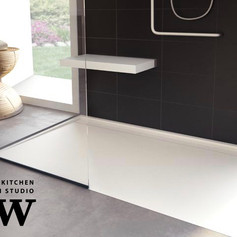Age in Place: Make Your Remodel Handicapped-Accessible
- Rachel Kurland
- Apr 10, 2018
- 4 min read
Note from Flow: This article we contributed to that appeared in the Jewish Exponent.
It's no surprise that 90 percent of people 65 and older would prefer to live in their own homes as they age, as opposed to a nursing home or assisted living facility, according to a recent AARP study.
But adding necessary equipment to your home doesn’t have to look like a hospital room. You can age in place — and in vogue.
Although the term is called “aging in place,” it’s important to remember to thrive in that place — your home.
“‘Aging in place’ is a misnomer,” concluded a 2016 HomeAdvisor report, titled Aging in Place. “Whether we’re 25, 45, 65 or 85, our homes aren’t for aging. They’re for thriving. From pancake breakfasts with our kids and Sunday brunches with our friends to holidays with family, movie nights with our spouses and curling up with a good book, our homes are where we do the things we love to do, with the people we love to do them with. Looking at aging in place through a new lens that acknowledges how we live — not just how long we live — will usher in a new generation of home-improvement projects that benefit the young, the young at heart and everyone in between.”
With that logic in mind, Rachel Lucks-Hecht, owner of Flow Bath + Kitchen Design Studio in Glenside, said her company offers plenty of home redesign options for aging in place.
Installments like curbless or doorless showers; partial shower doors and wide doors; wall-hung vanities or vanities with legs; and shallower sinks and cabinets make it easily accessible without the fear of tripping. And those in wheelchairs can simply roll in.

A wall-hung sink and vanity | Photo by Flow Bath + Kitchen Design Studio
Single-handed faucets and levers, or even touch faucets that turn on by tapping it, also aid people with Parkinson’s, arthritis or other dexterity issues, as opposed to cross handles or knobs.
Lower tubs or tubs with doors make it uncomplicated to get in and out, especially when accompanied by installed shower seats. Some fold down, too, to move out of the way, which Lucks-Hecht added are also “beautiful.”
“Their bathroom should fit their style. Their bathroom is the only place where you can be alone sometimes,” she laughed, “and it can be very functional and beautiful. People can confidently feel that they’re going to be safe in their home.”
The additional equipment allows people to enjoy their space more, too, and Lucks-Hecht said they won’t necessarily need help with everything as much. Hand showers on a hose are a popular advantage, as are grab bars.
“Grab bars are super important,” she added, which can be installed by the toilet or in the shower, “and we have pretty grab bars. The colors, the shape of them, it’s not like the hospital-looking grab bars.” That way, she said, those trying to maintain their stylish bathroom can easily find helpful tools that also match their color scheme.
Grab bars at Flow range from $50 to $500, depending on the finish. Gold is a luxurious option, as well as brass and pewter.
“People want all their accessories to match,” she said.
Photos by Flow Bath + Kitchen Design Studio
touch-activated faucet
shower bench
high-raised toilet
curbless open shower with bench, hand shower and grab bar
Lucks-Hecht said it’s better for older adults to make these internal adjustments earlier on, if possible.
“People are staying in their houses for much longer. They don’t really want to go to a nursing home when they’re older or assisted living. Setting up their bathroom for longevity is really important,” she said.
Peter Abraldes, director of operations for NursePartners Inc., said most of his clients are living with a form of dementia, so the company staffs facilities and provides one-on-one care in the home or at facilities.
NursePartners is just one business member of the Philadelphia chapter of the National Aging in Place Council, of which Abraldes is the co-founder.
“We strive to provide families with a vetted pool of service providers that can help them with all of the needs associated with aging in place,” he explained, which include home care, home modification, bookkeeping services, hospice services, trash removal, medical alert systems or social services.
Abraldes recommended a stairlift to add to the home. “Once an older adult can no longer go up and down the stairs successfully, that’s when a lot of families decide, ‘Do I want to stay in this home? Do I want to downsize?’”
He said many who live outside of Philadelphia opt for the lifts, while those in old rowhomes in the city are too narrow to alter.
As another option, many redo the first floor as their livable space and often add bathrooms to the layout.
“We’ve seen people convert entire rooms into bathrooms, where everything is tile,” he noted of clients with muscular dystrophy, who build accessible options before the disease progresses. “They’re anticipating a future when one day they won’t be able to walk into the bathroom. They’ll have to be wheeled, so essentially the room becomes a shower.”
These additions allow people to fully enjoy their homes, Abraldes said, whereas others who install temporary solutions only utilize a small portion of their home.
On the slimmer side, Abraldes noted many children gift their older adult parents medical alert systems. But in lieu of bulky devices like Life Alert, he suggested Tile Mate, a small bluetooth tracker paired with an app that is often used to find misplaced keys, or PocketFinder, another personal GPS locator. “You can actually attach that right onto a shoe or a favorite sweater, and it works well.”
Although they are not specified devices for older adults, they do the trick — and in a more stylish, sleek and conventional fashion.
Take baby steps with upgrading your home: On a DIY level, you can install night lights in bathrooms and hallways — Wayfair has stylish LED designs or you can opt for a concealed solid color to match your walls.
And instead of ditching your chic rugs and throws, apply non-slip or doubled-sided tape to the bottom of the rug to avoid slips.
When it’s time to call a contractor, remember a few of these options for a more accessible home:
Install a Lazy Susan in corner cabinets or pull-out shelves under counters.
Use lever faucets and door handles instead of round knobs.
Use rocker-style light switches instead of toggle switches.
Use grab bars, not towel or suction-cup bars.
Add railings to both sides of your staircase.
Add a no-step entrance to your doorway.














Comments